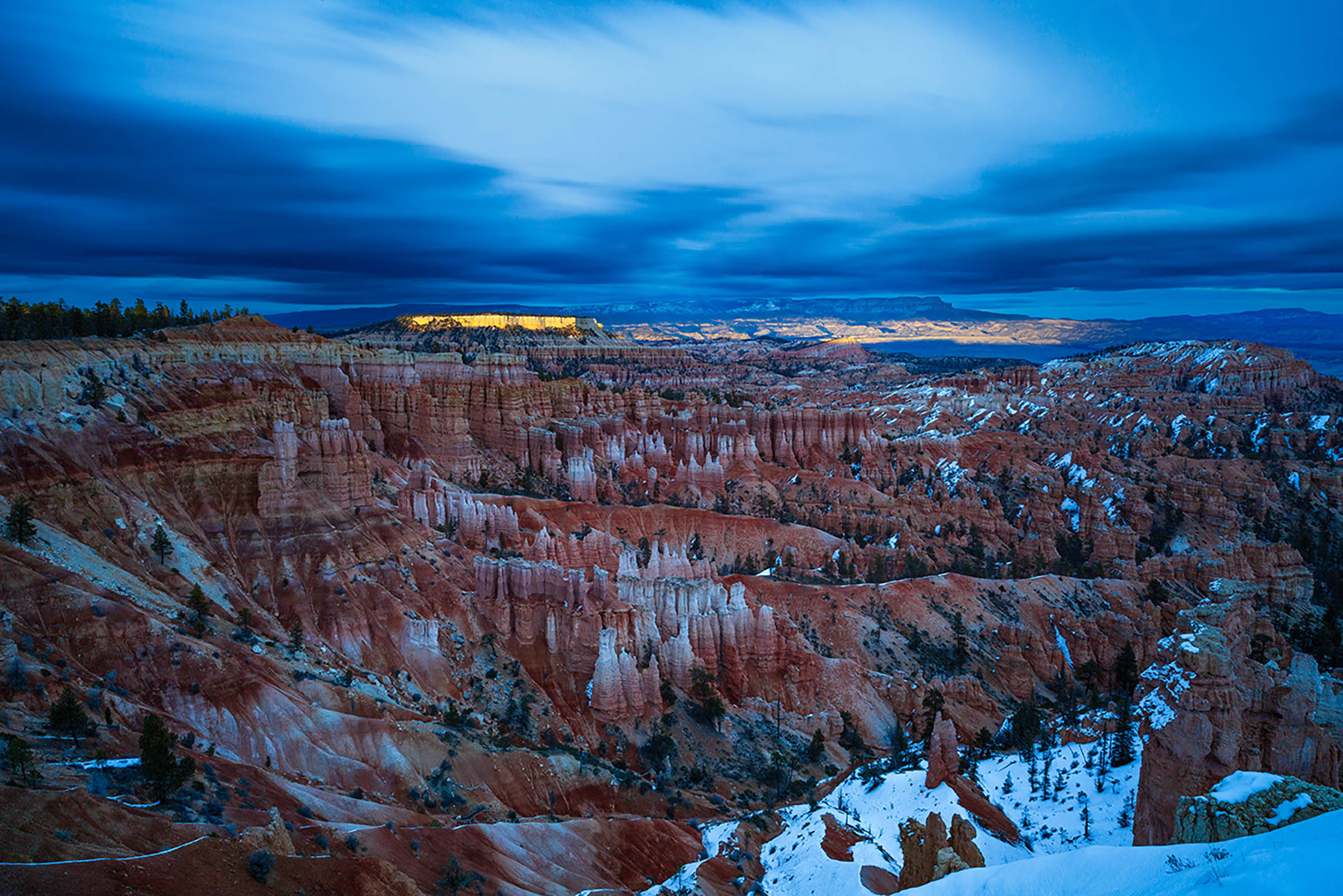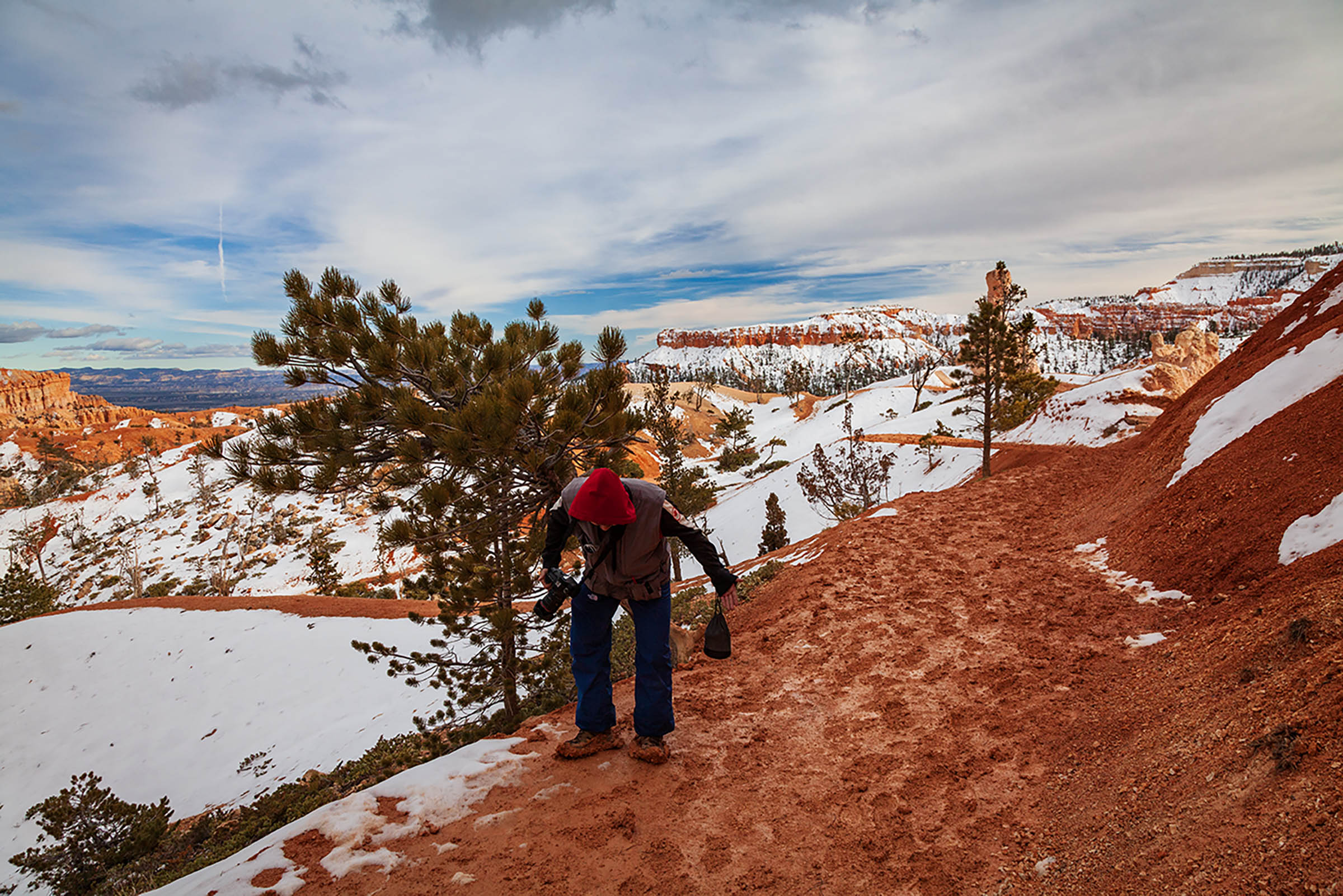Surprise Triumph During A Dull Sunset At Bryce Canyon National Park, Utah
A lackluster sunset at Bryce Canyon National Park yields a trophy photo.
14 January, 2025
~ 8 min read
Landscape photography involves a lot of planning, traveling, cost, and determination. One has to ‘be physically there’ when the nature unfolds its magic. Lots can go wrong and they will. One has to hold on to the last bit of hope and be creative when the stars don’t align. This is one such story and a photograph that turned out to be unforgettable!

On the heels of the Alaska photography trip (covering the Denali National Park, in Aug 2013), I wanted to visit, experience and photograph more landscapes (read National Parks). Each passing day, the drive to visit and photograph all the national parks of the United States started taking shape as a personal goal.
As the winter was approaching, I knew the best bet was to go to a state where the summer temperatures are normally high, so the weather wouldn’t be horrible. Southern California, Nevada, Arizona and Utah were on the list. After some more research, I settled on Utah, which has five national parks. If I planned well, I could cover all of them in one trip. Of these five parks, I have visited the Arches National Park in June 2005 during a cross-country road trip. I was shooting with a film SLR (Single Lens Reflex) camera then.
My photography buddy wanted to join this trip as well. We chose a late February 2014 weekend. Took a few of days off from work. We planned to fly into Las Vegas. Flights in and out of Las Vegas are normally cheaper. Probably due to the fact that people from all over the United States and beyond flock to the sin city all year long. We booked flight tickets, hotels, camping spots, and the rental car.
Utah’s five national parks are vastly different from each other despite being geographically close. Driving across the state just takes about eight hours. Arches NP famous for its 2000+ naturally formed stone arches, is the eastern most in the state. Canyon Lands NP has the spectacular views of vast canyons and is home to the world-famous Mesa Arch. Witnessing sunrise here is a heavenly experience. Bryce Canyon NP further west is known for its unique hoodoos. Zion NP is known for its beautiful landscapes and dizzying trails. We skipped Capitol Reef NP and I haven’t visited it as of this writing. On hindsight, we should have covered this park as well.
The itinerary (Feb 26, 2014 - Mar 03, 2014): Day 1 - Fly to Las Vegas + stay. Day 2- Drive to Moab + stay. Day 3 - Visit Arches National Park and camp there that night. Day 4 - Visit the Canyon Lands National Park. Then drive to Bryce Canyon National Park + stay. Day 5 - Visit the Bryce Canyon National Park and drive to Zion National Park + stay. Day 6 - Visit Zion National Park. Then head to Las Vegas and fly back home. Accommodations were less than half of the peak season pricing. Sweet!
I did enough homework finding best spots in each park for photography. For the Bryce Canyon National Park, I have chosen the places to be for sunrise and sunset hours. After having had a great time during sunrise and taking some good shots, we did a hike through the hoodoos during the day. Snow and rain combined with the sandstone dirt in those trails created a slippery mess. Our boots felt like they were made of lead, making the hike a punishment. Doing it with our camera backpacks wasn’t what you would call ‘a walk in the park’. But the experience was once in a lifetime opportunity. Finally, we reached the location we chose for the sunset hour on time.


The photo of this story was taken from this location. Getting here does not need any crazy hike or planning. It is on a trail close to parking, meant for the tourists. If you are there during the sunset, and brought some luck along with you, you will be rewarded with a great spectacle. After looking around for a ‘good’ spot, I setup my tripod, fixed the camera and got ready. I knew the exact time of sunset. The vista in front of us faces west. It was hard to see the cloud cover over western horizon with the canopy of trees behind me. So, if I was lucky and the clouds did not play spoilsport, the view would have been lit up with the golden light. But nature had other plans.
Up to 8 minutes before the scheduled sunset time, there was no sign of the soft, golden light. There were no leading indicators of that happening within those 8 minutes as well. On a clear day, the valley of hoodoos should have been lit up by now. So, I had to change my plan quickly. I carry with me ‘the big stopper’, a 10 stop neutral density filter in my photography trips. These filters cut down the Iight going into the lens. The 10-stop filter cuts down a LOT of light. I fixed it to the lens and set the camera to the bulb mode. Began shooting a really long, 362 second (6 minutes!) shot, hoping to capture the cloud movement along with the hoodoo valley.
At about the 220 second mark, there it was! The sunset’s gorgeous golden glow started painting on the sandstone mountain range at the far end of the valley. As if the cloud gods heard my prayer and offered a small boon! There was some gap in the cloud cover letting the sunset light through. I still vividly remember the excitement and delight I felt at that moment. Though the lens had a 10-stop filter, I knew this light painting would be captured in the long exposure, because of its intensity.
A long exposure photo will suffer from added noise due to the digital sensor heating up. Modern cameras have a feature called ‘Long Exposure Noise Reduction’. When turned on, the camera will take another shot of almost equal shutter release time, but with the mirror down and shutter closed (i.e., no light hitting the sensor). The camera software will use the data from this exposure to cancel any noise from the actual exposure programmatically. Long story short, a 362 second exposure will need ~700 seconds (~12 minutes) to complete. Believe me, it felt like a year!
When the camera’s LCD finally lighted up with the image, I was elated. I have a priced possession! The big stopper ensured the clouds had ‘a movement’ in a still photo! I zoomed in on the image and ensured that there was no camera shake. As soon as I went back to the hotel that night (which was hours of drive away at Zion National Park), I backed up the images and especially this image twice in a redundant storage.
The equipment: Camera - Canon 5D Mark II. The glass was my beloved Zeiss Distagon T* 21mm/f2.8 ZE. The tripod was a Manfrotto 055CXPRO3 Carbon Fiber. Sitting on top was the Acratech GP Ballhead. And the Canon TC-80N3 Timer Remote Controller. I have talked about the Zeiss manual prime lenses in my blog here. This photo is another example that proves their superiority in image making. This lens is my own. I could not resist the urge to buy my own for too long and ended up buying a used copy through eBay.
In my sojourns to various national parks before and after this, I have brought home some memorable images. It is amazing to me that my wife rates this image still as her personal favorite. A 36-inch x 24-Inch print has been enhancing our hallway all these years, reminding me the experience, every time I glimpse it. I hope you are able to appreciate the image with all this context. Next time you visit a national park, or any new place, try to see that place during a sunrise or sunset. Nature is a magician during those short periods of the day!